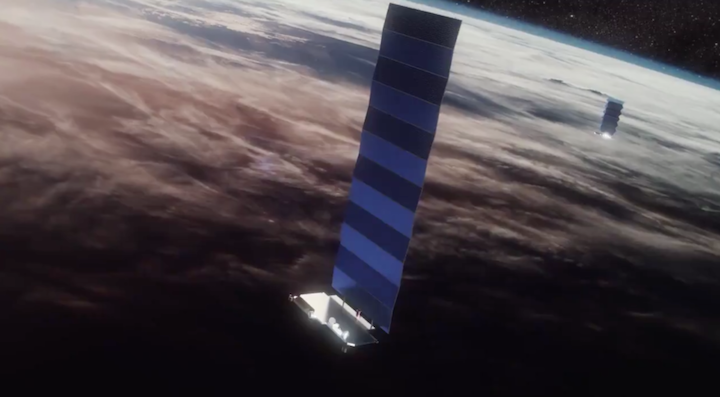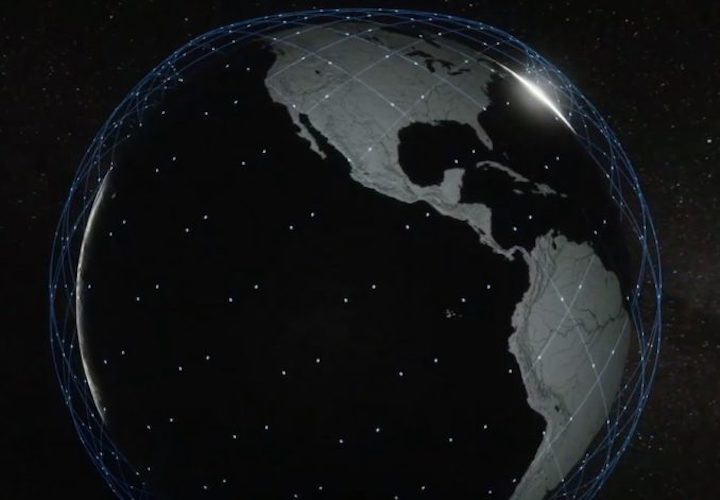23.04.2020

MT LAUREL, New Jersey — SpaceX is asking the FCC for permission to operate all 4,400 of its first-generation Starlink satellites at much lower altitudes than previously planned.
Of the 12,000 Starlink satellites SpaceX plans to eventually launch in its quest to build a global broadband network, the initial third — some 4,400 satellites with Ku-band downlinks and Ka-band uplinks — were originally approved to operate roughly 1,200 kilometers above Earth. Last April, the FCC approved SpaceX’s request to operate nearly 1,600 of the first-generation satellites at 550 kilometers.
On Friday, with its seventh Starlink deployment launch just days away, SpaceX asked the FCC for authorization to operate the remaining 2,800 of the 4,400 first-generation Starlink satellites between 540 and 570 kilometers instead of the 1,100 to 1,325-kilometer orbits originally approved.
SpaceX has touted lower altitudes as a key element of its plans to prevent space debris, since gravity will pull dead satellites below 650 kilometers into Earth’s atmosphere within 25 years.
The bulk of SpaceX’s planned constellation — a second-generation system of 7,500 V-band satellites the company has yet to start launching — are already cleared by the FCC for orbits between 335 and 346 kilometers.
SpaceX has deployed 362 Starlink satellites, including two prototypes, into 550-kilometer orbits. Its next 60 satellites are scheduled to launch aboard a Falcon 9 rocket April 22 from Cape Canaveral, Florida.
The April 17 request is SpaceX’s third time in 12 months seeking FCC permission to change its approved constellation architecture since the FCC first cleared the company in 2018 to provide service with the 12,000-satellite megaconstellation.
Following last April’s approval of SpaceX’s request to operate 1,584 first-generation Starlink satellites at lower altitudes, the FCC in December approved a follow-up request to divide those satellites among three times as many 550-kilometer orbital lanes. SpaceX said the change would accelerate Starlink coverage for the contiguous United States.
Both of SpaceX’s prior requests for constellation changes were met with resistance. A half-dozen satellite operators, for example, urged the FCC to delay or reject the December request for more orbits.
SpaceX is anticipating resistance to its latest proposed change from smallsat companies that operate or plan to operate satellites near Starlink but without propulsion.
In its April 17 request, SpaceX told the FCC that it has “repeatedly made clear that it intends to conduct active maneuvers to avoid collisions with both debris and other spacecraft throughout the life of its satellites.” Starlink satellites have five-year design lives.
Astronomers may also resist the altitude change, since Starlink satellites are brighter in lower orbits. SpaceX said the lower orbit could have an upside for astronomers, however, since Starlink satellites would spend more time in Earth’s shadow not catching the sun’s glare.
SpaceX has found some success reducing reflectivity with DarkSat, a Starlink satellite painted with a dark coating, but optical interference remains a concern for astronomers. In its April 17 filing, SpaceX said it is “developing new mitigation efforts that it plans to test in the coming months.”
Quelle: SN
+++
SpaceX modifies Starlink network design as another 60 satellites gear up for launch

Another 60 Starlink satellites are ready for launch Wednesday to beam Internet signals to future SpaceX consumers as the company seeks regulatory approval to fly all 4,400 relay stations in the network’s first phase of deployment at lower altitudes than previously planned.
SpaceX’s Starlink network is a multibillion-dollar program aimed at blanketing the planet in broadband connectivity, serving a wide range of consumers in homes, businesses, schools and hospitals. The network, which could eventually number thousands of satellites, is also designed to provide connectivity to airplanes and ships, and the U.S. military is testing the Starlink service to gauge its military usefulness.
“With performance that far surpasses that of traditional satellite Internet, and a global network unbounded by ground infrastructure limitations, Starlink will deliver high speed broadband internet to locations where access has been unreliable, expensive, or completely unavailable,” SpaceX says.
SpaceX has launched 360 Starlink satellites on six Falcon 9 rockets since last May. Another 60 are scheduled for launch Wednesday at 3:37 p.m. EDT (1937 GMT) from pad 39A at NASA’s Kennedy Space Center in Florida.
Sporting a previously-flown first stage and a recycled payload fairing, the Falcon 9 rocket will be fueled with super-chilled, densified kerosene and liquid oxygen propellants beginning around 35 minutes prior to liftoff.
There is a 90 percent chance of acceptable weather conditions for launch Wednesday, according to an outlook issued by the U.S. military’s 45th Weather Squadron at Cape Canaveral. SpaceX says it moved up the launch by a day from Thursday to take advantage of the good weather forecast.
The Falcon 9’s engine controller will command ignition of the rocket’s nine Merlin 1D main engines around three seconds before liftoff. The engines will power up to full throttle and hold-down clamps will open to allow the 229-foot-tall (70-meter) launcher to take off from pad 39A with 1.7 million pounds of thrust.
Heading toward the northeast, the Falcon 9 rocket will surpass the speed of sound in about one minute, then shut down its first stage engines roughly two-and-a-half minutes into the mission. The 15-story first stage booster will separate and attempt a propulsive landing on SpaceX’s drone ship parked several hundred miles northeast of Cape Canaveral in the Atlantic Ocean.
The Falcon 9’s second stage will fire its single Merlin engine to power the 60 quarter-ton Starlink satellites into orbit. Early in the second stage burn, the rocket will jettison its clamshell-like nose shroud once it has climbed above the dense, lower layers of the atmosphere.
SpaceX’s two fairing recovery boats will also be on station in the Atlantic Ocean east of Charleston, South Carolina, to try to snare the two fairing halves in giant nets for potential reuse on a future mission.
The fairing on Wednesday’s mission previously launched last August with the Israeli Amos 17 communications satellite, and were recovered at sea. The first stage assigned to Wednesday’s flight is a veteran of three previous launches and landings, including on the unpiloted test flight of SpaceX’s Crew Dragon capsule in March 2019.
If all goes according to plan, the Falcon 9’s second stage will shut down its engine nearly nine minutes after liftoff, injecting the Starlink satellites into a preliminary elliptical orbit ranging more than 200 miles (300 kilometers) above Earth.
The 60 Starlink spacecraft will deploy from the Falcon 9 upper stage all at once over the North Atlantic Ocean around 14 minutes into the mission.
Each of the quarter-ton Starlink satellites is expected to unfurl a solar array wing and activate a krypton ion propulsion drive to begin climbing to an operational orbit 341 miles (550 kilometers) in altitude, where they will join hundreds other Starlink nodes launched since last May.
SpaceX has modified the architecture of the Starlink network several times. Most recently, SpaceX submitted an application to the Federal Communication Commission on Friday proposing to operate more satellites in lower orbits than the FCC previously authorized.
The first phase of the Starlink network will include 1,584 satellites orbiting 341 miles (550 kilometers) above Earth in planes inclined 53 degrees to the equator. That part of the constellation, which SpaceX intends to launch through the end of the year, remains unchanged in SpaceX’s application.
SpaceX previously had regulatory approval from the FCC to operate another 2,825 satellites in higher orbits between 690 miles (1,110 kilometers) and 823 miles (1,325 kilometers) in altitude, in orbital planes inclined 53.8, 70, 74 and 81 degrees to the equator.
The modified plan submitted to the FCC by SpaceX foresees Ku-band and Ka-band satellites in the next phase of the Starlink network all operated at altitudes between 335 miles (540 kilometers) and 354 miles (570 kilometers) at inclinations of 53.2, 70 and 97.6 degrees.
The application covers 4,408 Starlink satellites, one fewer than SpaceX envisioned under the previous architecture.
In documentation submitted Friday to the FCC, SpaceX said lower altitude will put the satellites closer to Starlink consumers and allow the network “to provide low-latency broadband to unserved and underserved Americans that is on par with service previously only available in urban areas.”
The change will also improve Starlink service for U.S. government users in polar regions and allow for more rapid deployment of the network, SpaceX said.
Flying Starlink satellites in lower orbits will help ensure they re-enter the atmosphere a shorter time in case of failure. And the spacecraft will broadcast signals at reduced power levels because they are closer to Earth, which SpaceX said will allow the Starlink fleet to be compliant with limits to reduce radio interference with other satellite and terrestrial wireless networks.
Last week’s application to modify SpaceX’s FCC license is the latest in a series of adjustments to the Starlink architecture. Before the first launch of 60 Starlink satellites last year, SpaceX received FCC approval to migrate the positions of the fleet’s first 1,584 satellites from 714 miles (1,150 kilometers) to 341 miles (550 kilometers).
In December, the FCC granted a SpaceX request to reconfigure the distribution of the Starlink satellites in different orbital planes. SpaceX said that request was intended to expand Starlink coverage faster around the United States without the need for more satellites.
SpaceX wrote in the FCC filing Friday that the Starlink network remains on track to begins serving American consumers this year.

At lower altitudes, the Starlink satellites will fly in a region with busier space traffic. SpaceX says its Starlink spacecraft can maneuver to avoid collisions with other objects in orbit, and it releases orbital data on the Starlink satellites so other operators can also perform evasive maneuvers.
Astronomers have also raised concerns about the brightness of the Starlink satellites, which could interfere with ground-based telescope images, particularly around sunrise and sunset.
The Starlink satellites reflect more sunlight than SpaceX or astronomers anticipated before the first dedicated Starlink launch last year. The American Astronomical Society and other groups are working with SpaceX to try and limit the satellites’ impacts on astronomy.
“SpaceX is committed to promoting all forms of space exploration, which is why it has already taken a number of proactive steps to ensure it does not materially impact optical astronomy,” the company wrote in Friday’s application to the FCC, which does not have regulatory authority over the brightness of satellites. “SpaceX is working with U.S. and international astronomy organizations and observatories to measure scientifically the actual impact of its satellites.”
Flying more Starlink satellites at lower altitudes could make the relay nodes appear brighter from the ground, but there will be fewer Starlink satellites visible in the sky at one time. The spacecraft at lower altitudes will also spend less time illuminated by sunlight.
One of 60 Starlink satellites launched Jan. 6 carried a new darker coating intended to reduce the spacecraft’s reflectivity. SpaceX said last month that preliminary data indicated a “notable reduction” in the brightness of that satellite, which has been dubbed “DarkSat.”
Beyond this (darkening) treatment, SpaceX is developing new mitigation efforts that it plans to test in the coming months,” SpaceX wrote in Friday’s FCC filing. “Additionally, SpaceX will make satellite tracking data available so astronomers can better coordinate their observations with our satellites.”
One change SpaceX is studying is the addition of a sunshade, or visor, to unfurl like an umbrella on Starlink satellites to reduce the amount of sunlight glinting off the spacecraft.
Beyond the 4,400 Ku-band and Ka-band satellites covered in Friday’s application for a modified FCC license, SpaceX plans to launch another 7,500 V-band data relay stations into orbits around 214 miles (345.6 kilometers) in altitude. The FCC has already approved SpaceX to operate the V-band network.
SpaceX’s next Starlink launch after Wednesday could happen as soon as early-to-mid May on another Falcon 9 rocket mission from Cape Canaveral.
Quelle: SN
